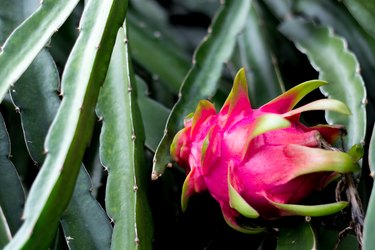
With a rock-star common name like "dragon fruit," this cactus had better deliver. And it does, with sweet, custard-like fruit and crunchy seeds. The dragon fruit (Hylocereus undatus) is also called the pitaya, the night-blooming cereus, and the strawberry pear. Native to the tropics, it thrives only in warm-winter climates.
Meet the Dragon Fruit Plant
Video of the Day
If you've never heard of a cactus that grows like a vine, it's time you met the dragon fruit plant. Native to tropical Mexico and Central and South America, the dragon fruit is an epiphyte in the wild, growing on other plants. In the garden, it is a fast-growing perennial, with jointed, triangular, many-branched stems that are green and fleshy. These stems can grow to 20 feet long, climbing and holding on with the aerial roots they form.
Video of the Day
It is impossible to confuse dragon fruit flowers with any other blossoms. They are huge — up to 14 inches long and 9 inches wide — and exceptionally showy. The blossoms are white or pink, bell-shaped, and open only at night. When pollinated, they produce the plant's fruit, equally unusual. It is an oblong fleshy berry with red or yellow scaly peels and often with spines.
About Dragon Fruit Zones
If you happen to live in tropical Central or South America, you should have no problem planting and growing dragon fruit. They thrive in tropical and some subtropical climates, including U.S. Department of Agriculture plant hardiness zones 10a through 11. It may be possible to grow them outdoors in USDA zone 9 with protection when it freezes. Note that the fruits can ripen independently of warm weather and do not rely on climatic conditions.
On the other hand, despite their tropical backstory, dragon fruit plants do not like it too hot. They will suffer in extreme heat when temperatures approach 100 degrees Fahrenheit. Their ideal climate for growth is one with temperatures between 65 and 77 degrees. Extremely hot sun can burn the stems of young plants. On the opposite side of the scale, they can tolerate temperatures down to 40 degrees and might shake off a light frost. A deep frost will kill them.
Grow a Dragon Fruit Plant
Dragon fruit can grow from the seeds found in the scaly fruit. The seeds germinate within 21 days, but it takes up to seven years for the plant to mature sufficiently to produce fruit. The easier, faster, preferable method of propagating these plants is through rooting cuttings. A cutting-grown plant will often fruit within one year.
Whichever method of propagation you use, give the dragon fruit plant well-drained, fertile soil and plenty of water. Plant it in full sun. The only exception to this is where the humidity is very low and the temperature very high. In that situation, the plant does better in dappled sun to prevent burn.